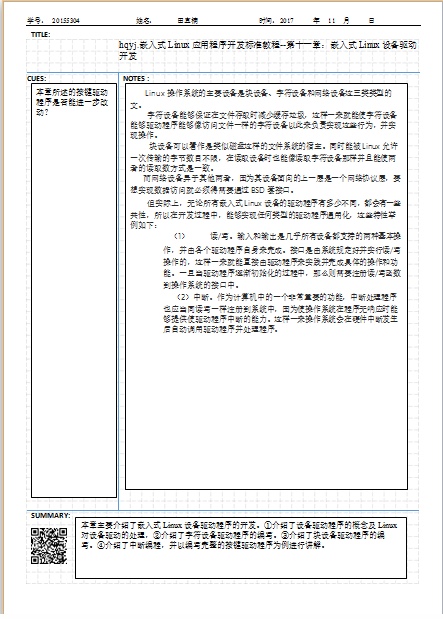2017-2018-1 20155304 20155332 实验四 外设驱动程序设计
实验四 外设驱动程序设计
实验四外设驱动程序设计-1
学习资源中全课中的“hqyj.嵌入式Linux应用程序开发标准教程.pdf”中的第十一章
提交康奈尔笔记的照片(可以多张)

实验四外设驱动程序设计-2
在Ubuntu完成资源中全课中的“hqyj.嵌入式Linux应用程序开发标准教程.pdf”中的第十一章的test试验
提交编译,加载模块,卸载模块,测试运行的截图(要多张,全屏,体现学号信息)
源代码如下:
/* test_drv.c */
#include <linux/module.h>
#include <linux/init.h>
#include <linux/fs.h>
#include <linux/kernel.h>
#include <linux/slab.h>
#include <linux/types.h>
#include <linux/errno.h>
#include <linux/cdev.h>
#include <asm/uaccess.h>
#define TEST_DEVICE_NAME "test_dev"
#define BUFF_SZ 1024
/*全局变量*/
static struct cdev test_dev;
unsigned int major =0;
static char *data = NULL;
/*函数声明*/
static ssize_t test_read(struct file *file, char *buf, size_t count, loff_t *f_pos);
static ssize_t test_write(struct file *file,const char *buffer, size_t count,loff_t *f_pos);
static int test_open(struct inode *inode, struct file *file);
static int test_release(struct inode *inode,struct file *file);
/*读函数*/
static ssize_t test_read(struct file *file, char *buf, size_t count, loff_t *f_pos)
{
int len;
if (count < 0 )
{
return -EINVAL;
}
len = strlen(data);
count = (len > count)?count:len;
if (copy_to_user(buf, data, count))
{
return -EFAULT;
}
return count;
}
/*写函数*/
static ssize_t test_write(struct file *file, const char *buffer, size_t count, loff_t *f_pos)
{
if(count < 0)
{
return -EINVAL;
}
memset(data, 0, BUFF_SZ);
count = (BUFF_SZ > count)?count:BUFF_SZ;
if (copy_from_user(data, buffer, count))
{
return -EFAULT;
}
return count;
}
/*打开函数*/
static int test_open(struct inode *inode, struct file *file)
{
printk("This is open operation\n");
data = (char*)kmalloc(sizeof(char) * BUFF_SZ, GFP_KERNEL);
if (!data)
{
return -ENOMEM;
}
memset(data, 0, BUFF_SZ);
return 0;
}
/*关闭函数*/
static int test_release(struct inode *inode,struct file *file)
{
printk("This is release operation\n");
if (data)
{
kfree(data);
data = NULL;
}
return 0;
}
static void test_setup_cdev(struct cdev *dev, int minor,
struct file_operations *fops)
{
int err, devno = MKDEV(major, minor);
cdev_init(dev, fops);
dev->owner = THIS_MODULE;
dev->ops = fops;
err = cdev_add (dev, devno, 1);
if (err)
{
printk (KERN_NOTICE "Error %d adding test %d", err, minor);
}
}
/* tests设备的file_operations结构 */
static struct file_operations test_fops =
{
.owner = THIS_MODULE,
.read = test_read,
.write = test_write,
.open = test_open,
.release = test_release,
};
/*模块注册入口*/
int init_module(void)
{
int result;
dev_t dev = MKDEV(major, 0);
if (major)
{
result = register_chrdev_region(dev, 1, TEST_DEVICE_NAME);
}
else
{
result = alloc_chrdev_region(&dev, 0, 1, TEST_DEVICE_NAME);
major = MAJOR(dev);
}
if (result < 0)
{
printk(KERN_WARNING "Test device: unable to get major %d\n", major);
return result;
}
test_setup_cdev(&test_dev, 0, &test_fops);
printk("The major of the test device is %d\n", major);
return 0;
}
/*卸载模块*/
void cleanup_module(void)
{
cdev_del(&test_dev);
unregister_chrdev_region(MKDEV(major, 0), 1);
printk("Test device uninstalled\n");
}
加载模块:
/*test_drv_load*/
#!/bin/sh
# 驱动模块名称
module="test_drv"
# 设备名称。在/proc/devices中出现
device="test_dev"
# 设备文件的属性
mode="664"
group="david"
# 删除已存在的设备节点
rm -f /dev/${device}
# 加载驱动模块
/sbin/insmod -f ./$module.ko $* || exit 1
# 查到创建设备的主设备号
major=`cat /proc/devices | awk "\\$2==\"$device\" {print \\$1}"`
# 创建设备文件节点
mknod /dev/${device} c $major 0
# 设置设备文件属性
chgrp $group /dev/${device}
chmod $mode /dev/${device}
卸载模块:
/*test_drv_unload*/
#!/bin/sh
module="test_drv"
device="test_dev"
# 卸载驱动模块
/sbin/rmmod $module $* || exit 1
# 删除设备文件
rm -f /dev/${device}
exit 0
test代码:
/* test.c */
#include <stdio.h>
#include <stdlib.h>
#include <string.h>
#include <sys/stat.h>
#include <sys/types.h>
#include <unistd.h>
#include <fcntl.h>
#define TEST_DEVICE_FILENAME "/dev/test_dev" /* 设备文件名*/
#define BUFF_SZ 1024 /* 缓冲大小 */
int main()
{
int fd, nwrite, nread;
char buff[BUFF_SZ]; /*缓冲区*/
/* 打开设备文件 */
fd = open(TEST_DEVICE_FILENAME, O_RDWR);
if (fd < 0)
{
perror("open");
exit(1);
}
do
{
printf("Input some words to kernel(enter 'quit' to exit):");
memset(buff, 0, BUFF_SZ);
if (fgets(buff, BUFF_SZ, stdin) == NULL)
{
perror("fgets");
break;
}
buff[strlen(buff) - 1] = '\0';
if (write(fd, buff, strlen(buff)) < 0) /* 向设备写入数据 */
{
perror("write");
break;
}
if (read(fd, buff, BUFF_SZ) < 0) /* 从设备读取数据 */
{
perror("read");
break;
}
else
{
printf("The read string is from kernel:%s\n", buff);
}
} while(strncmp(buff, "quit", 4));
close(fd);
exit(0);
}


实验四外设驱动程序设计-3
在实验箱中通过交叉编译完成test实验
提交编译,加载模块,卸载模块,测试运行的截图(要多张,全屏,体现学号信息)
未完成
实验中的问题及解决过程
问题1:
运行load脚本出现错误insmod: error inserting './test_drv.ko': -1 File exists
解决:这个原因一般是因为,运行过./test_drv_load(没加sudo),但是失败了,但是运行到了加载驱动的模块的语句,驱动已经加载,所以再次运行加载模块会提示该错。
新学到的知识点
- 驱动硬件、驱动程序、内核模块的概念
- lsmod、rmmod、insmod、modprobe等指令的用法
- 如何通过文件属性查看设备及其分类
- 了解驱动层次结构,驱动程序包含的两种程序
- 简单虚拟设备驱动程序编写、编译、加载、卸载
- 查看内核打印信息





